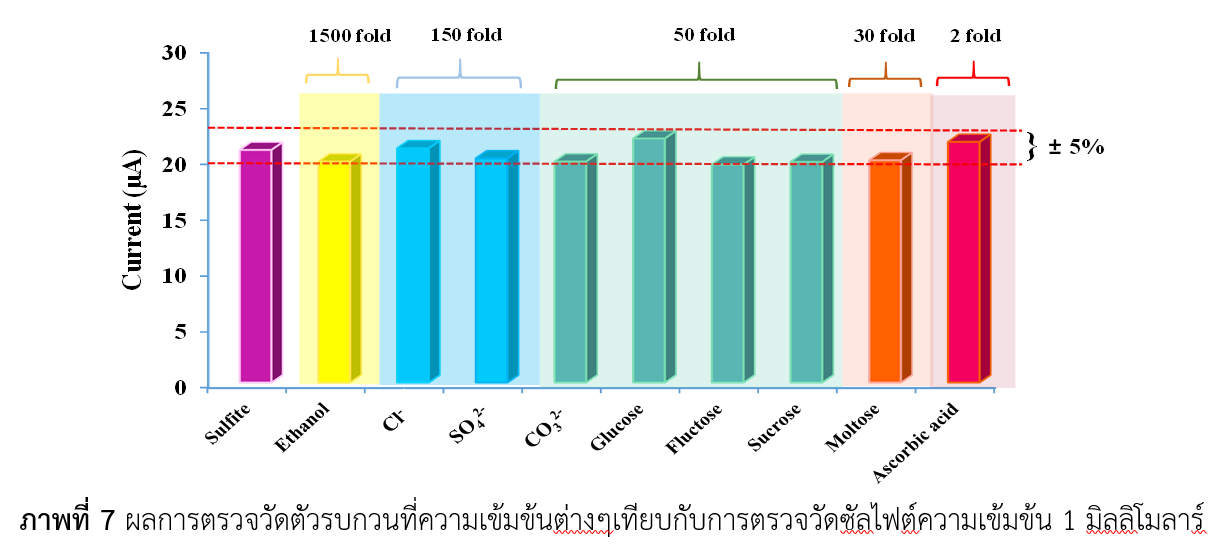การพัฒนาซัลไฟต์เคมิคัลเซนเซอร์โดยการดัดแปรขั้วไฟฟ้าชนิดกลาสซีคาร์บอน ด้วยอนุภาคนิกเกิล-แมกนีไทต์นาโนสำหรับใช้ในตัวอย่างอาหาร
Main Article Content
บทคัดย่อ
งานวิจัยนี้พัฒนาเคมิคัลเซนเซอร์สำหรับวิเคราะห์ปริมาณซัลไฟต์ด้วยเทคนิควิเคราะห์ทางเคมีไฟฟ้าที่มีความจำเพาะและสภาพไวสูง เคมิคัลเซนเซอร์พัฒนาขึ้นโดยอาศัยการดัดแปรขั้วไฟฟ้ากลาสซีคาร์บอนด้วยวัสดุเชิงประกอบของแมกนีไทต์ (Fe3O4) และอนุภาคนิกเกิลขนาดนาโนตกแต่งบนท่อนาโนคาร์บอน (Fe3O4-CNTs-NiNPs) อนุภาคแมกนีไทต์ขนาดนาโนถูกบรรจุอยู่บนผิวหน้าของท่อนาโนคาร์บอนแบบผนังหลายชั้นที่มีหมู่ฟังก์ชันคาร์บอกซิลิกด้วยกระบวนการตกตะกอนร่วม ส่วนอนุภาคนิกเกิลขนาดนาโน (NiNPs) เตรียมขึ้นโดยการรีดิวซ์นิกเกิลคลอไรด์ด้วยไฮดราซีนไฮเดรท จากนั้นนำไปตกแต่งบน Fe3O4-CNTs โดยกระบวนการโซนิเคท เคมิคัลเซนเซอร์ที่พัฒนาขึ้น (Fe3O4-CNTs-NiNPs/GC) ถูกนำไปใช้สำหรับตรวจวัดปฏิกิริยาออกซิเดชันของซัลไฟต์ (SO32-) ด้วยเทคนิค ลิเนียร์สวีฟ โวลแทมเมทรีในสารละลายอิเล็กโตรไลต์เกื้อหนุน ฟอสเฟตบัฟเฟอร์ ความเข้มข้น 0.1 โมลาร์ พีเอช 7.0 ผลการทดลองพบว่าซัลไฟต์เกิดปฏิกิริยาออกซิเดชันที่ศักย์ไฟฟ้า +0.38 โวลต์ ค่ากระแสออกซิเดชันจากสารละลายซัลไฟต์มีช่วงการตอบสนองแบบเป็นเส้นตรงในช่วง 0.1 ถึง 10 มิลลิโมลาร์ มีสภาพไวเท่ากับ 12.75 ไมโครแอมแปร์ต่อมิลลิโมลาร์ ขีดจำกัดต่ำสุดในการตรวจวัดเท่ากับ 28 ไมโครโมลาร์ (S/N = 3) ขั้วไฟฟ้าที่พัฒนาขึ้นสามารถเก็บไว้ได้นานถึง 3 สัปดาห์ที่อุณหภูมิห้อง มีสภาพไว มีความจำเพาะเจาะจงในการตรวจวัดที่ดี และขั้นตอนการเตรียมไม่ยุ่งยาก นอกจากนี้ขั้วไฟฟ้าที่พัฒนาขึ้นสามารถนำมาประยุกต์ใช้ในการตรวจวัดซัลไฟต์ในตัวอย่างไวน์ และอาหารได้อย่างมีประสิทธิภาพ
Article Details
วารสารวิทยาศาสตร์และวิทยาศาสตร์ศึกษา (JSSE) เป็นผู้ถือลิสิทธิ์บทความทุกบทความที่เผยแพร่ใน JSSE นี้ ทั้งนี้ ผู้เขียนจะต้องส่งแบบโอนลิขสิทธิ์บทความฉบับที่มีรายมือชื่อของผู้เขียนหลักหรือผู้ที่ได้รับมอบอำนาจแทนผู้เขียนทุกนให้กับ JSSE ก่อนที่บทความจะมีการเผยแพร่ผ่านเว็บไซต์ของวารสาร
แบบโอนลิขสิทธิ์บทความ (Copyright Transfer Form)
ทางวารสาร JSSE ได้กำหนดให้มีการกรอกแบบโอนลิขสิทธิ์บทความให้ครบถ้วนและส่งมายังกองบรรณาธิการในข้อมูลเสริม (supplementary data) พร้อมกับนิพนธ์ต้นฉบับ (manuscript) ที่ส่งมาขอรับการตีพิมพ์ ทั้งนี้ ผู้เขียนหลัก (corresponding authors) หรือผู้รับมอบอำนาจ (ในฐานะตัวแทนของผู้เขียนทุกคน) สามารถดำเนินการโอนลิขสิทธิ์บทความแทนผู้เขียนทั้งหมดได้ ซึ่งสามารถอัพโหลดไฟล์บทความต้นฉบับ (Manuscript) และไฟล์แบบโอนลิขสิทธิ์บทความ (Copyright Transfer Form) ในเมนู “Upload Submission” ดังนี้
1. อัพโหลดไฟล์บทความต้นฉบับ (Manuscript) ในเมนูย่อย Article Component > Article Text
2. อัพโหลดไฟล์แบบโอนลิขสิทธิ์บทความ (Copyright Transfer Form) ในเมนูย่อย Article Component > Other
ดาวน์โหลด ไฟล์แบบโอนลิขสิทธิ์บทความ (Copyright Transfer Form)
References
Abass, A.K. Hart, J.P. and Cowell, D. (2000). Development of an amperometric sulfite biosensor based on sulfite oxidase with cytochrome c, as electron acceptor, and a screen-printed transducer. Sensors and Actuators B, 62, 148–153.
Amatatongchai, M. and et al. (2015). Simple flow injection for determination of sulfite by amperometric detection using glassy carbon electrode modified with carbon nanotubes–PDDA–gold nanoparticles. Talanta, 133, 134-141.
Bahmani B. and et al. (2010). Development of an electrochemical sulfite biosensor by immobilization of sulfite oxidase on conducting polyaniline film. Synthetic Metals, 160(23-24), 2653-2657.
Bonifcio, R. L and Coichev, N. (2004). Chemiluminescent determination of sulfite traces based on the induced oxidation of Ni(II)/tetraglycine complex by oxygen in the presence of luminol: mechanistic considerations. Analytica Chimica Acta. 517(1-2), 125-130.
Dadamos, T. R. L. and Teixeira, M. F. S. (2009). Electrochemical sensor for sulfite determination based on a nanostructured copper-salen film modified electrode. Electrochimica Acta, 54(19), 4552-4558.
Fatoni, A., and et al. (2013). A highly stable oxygen-independent glucose biosensor based on a chitosan-albumin cryogel incorporated with carbon nanotubes and ferrocene. Sensors and Actuators B, 185, 725-734.
Garcia, T. and et al. (2005). Electrochemical sensor for sulfite determination based on iron hexacyanoferrate film modified electrodes. Sensors and Actuators B, 106(2), 803-809.
Gavalas, V. G. and et al. (2004). Carbon nanotube aqueous sol-gel composites: enzyme-friendly platforms for the development of stable biosensors. Analytical Biochemistry, 329(2), 247-252.
Hassan, S. S. M., Hamza, M. S. A. and Mohamed, A. H. K. (2006). A novel spectrophotometric method for batch and flow injection determination of sulfite in beverages. Analytica Chimica Acta, 570(2), 232-239.
Iijima, S. (1991). Helical microtubules of graphitic carbon. Nature, 354, 56–58.
Jankovskiene, G., Daunoravicius, Z. and Padarauskas, A. (2001). Capillary electrophoretic determination of sulfite using the zone-passing technique of in-capillary derivatization. Journal of Chromatography A, 934(1-2), 67-73.
Kaushik, A. and et al. (2008). Chitosan iron oxide nanobiocomposite based immunosensor for ochratoxin-A. Analytical Communications, 10(9), 1364-1368.
Kul, D., and et al. (2013). A novel amperometric sensor for ascorbic acid based on poly(Nile blue A) and functionalised multi-walled carbon nanotube modified electrodes. Talanta, 111, 76-84.
Lin, Y. Cui, X. and Ye, X. (2005). Electrocatalytic reactivity for oxygen reduction of palladium-modified carbon nanotubes synthesized in supercritical fluid. Electrochemistry Communications, 7(3), 267-274.
Merkoi, A. and et al. (2005). New materials for electrochemical sensing VI: Carbon nanotubes. TrAC Trends in Analytical Chemistry, 24(9), 826-838.
Miller, J. N. and Miller, J. C. (2010). Statistics and Chemo metrics for Analytical Chemistry (6th ed). Pearson Education Limited, Essex.
Montaño, A. and et al. (2004). Vitamin Content and Amino Acid Composition of Pickled Garlic Processed with and without Fermentation. Journal of Agricultural and Food Chemistry, 52 7324-7330.
Nontawong, N. and et al. (2016). Non-enzymatic glucose sensors for sensitive amperometric detection based on simple method of nickel nanoparticles decorated on magnetite carbon nanotubes modified glassy carbon electrode. International journal of electrochemical science, 12, 1362-1376.
Puangmali, T. (2013). Magnetic nanoparticles for drug targeting: A magic bullet for cancer therapy (in Thai). KKU Science Journal, 41(3), 607-620.
Rawa, L. R., Chawla, S. and Pundir, C. S. (2011). Polyphenol biosensor based on laccase immobilized onto silver nanoparticles/multiwalled carbon nanotube/ polyaniline gold electrode. Analytical Biochemistry, 419(2), 196-204.
Satienperakul, S., Phongdong, P. and Liawruangrath, S. (2010). Pervaporation flow injection analysis for the determination of sulphite in food samples utilising potassium permanganate–rhodamine B chemiluminescence detection. Food Chemistry, 121(3), 893-898.
Sensri, Y., Chairam, S., Nacapricha, D. and Amatatongchai, M. (2011). Development of a biosensor based on the matrix of carbon nanotubes-chitosan composite for laccase-catalyzed oxygen reduction (in Thai). Burapha Science Journal, 16(2), 40-50.
Sroysee, W. and et al. (2016). A sensitive and selective on-line amperometric sulfite biosensor using sulfite oxidase immobilized on a magnetite-gold-folate nanocomposite modified carbon-paste electrode. Talanta, 156-157, 154-162.
Teymourian, H. Salimi, A. and Hallaj, R. (2013). Low potential detection of NADH based on Fe3O4 nanoparticles/multiwalled carbon nanotubes composite: Fabrication of integrated dehydrogenase-based lactate biosensor. Biosensors and Bioelectronics, 33(1), 60-68.
Theisen, S. and et al. (2010). A fast and sensitive HPLC method for sulfite analysis in food based on a plant sulfite oxidase biosensor. Biosensors and Bioelectronics, 26(1), 175-181.
Tzanavaras, P. D., Thiakouli, E. and Themelis, D. G. (2009). Hybrid sequential injection flow injection manifold for the spectrophotometric determination of total sulfite in wines using o-phthalaldehyde and gas-diffusion. Talanta, 77(5), 1614-1619.
Wang, J. and et al. (2002). Oxygen independent poly(dimethylsiloxane)-based carbon-paste glucose. Biosensors and Bioelectronics, 17, 999-1003.
Wang, J. Musameh, M. and Lin, Y. (2003). Solubilization of Carbon Nanotubes by Nafion toward the Preparation of Amperometric Biosensors. Journal of the American Chemical Society, 125, 2408-2409.
Wang, Q. and et al. (2007). Room-temperature ionic liquids/multi-walled carbon nanotubes/chitosan composite electrode for electrochemical analysis of NADH. Electrochimica Acta, 52(24), 6630-6637.
Welch, C.M. and Compton, R.G. (2006). The use of nanoparticles in electroanalysis: a review. Analytical and Bioanalytical Chemistry, 384(3), 601-619.
Wu, X. and et al. (2012). Nickel nanoparticles prepared by hydrazine hydrate reduction and their application in supercapacitor. Power Technology, 224, 162-167.
Yilmaz, M. T. and Somer, G. (2007). Determination of trace sulfite by direct and indirect methods using differential pulse polarography. Analytica Chimica Acta, 603(1), 30-35.
Zhou, H., Yang, W. and Sun, C. (2008). Amperometric sulfite sensor based on multi-walled carbon nanotubes/ferrocene-branched chitosan composites. Talanta, 77(1), 366-371.

